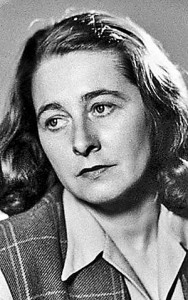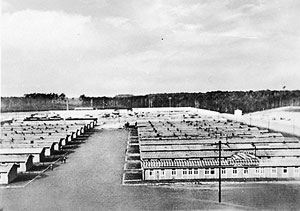A tale of two horrors, Nazism and Stalinism

Margarete Buber-Neumann
“We looked at the railway bridge which was the border between Poland occupied by the Germans and Poland occupied by the Russians. A soldier slowly walked over the bridge, coming towards us. When he arrived closer, I recognized the cap of the SS. On the other side of the Brest-Litowsk bridge, we saw a small wooden hut. Betty Oldberg was tottering from weakness, cold and emotion. Someone suggested: ‘Carry her inside the hut!’ They let us both coming inside. An SS, his tracker dog beside him, opened us the door. For the first time I closely saw an SS cap, with skull and crossbones and below, a real SS face.”
Margarete Buber-Neumann (1901-1989) twice faced extermination; once from Stalin and once from Hitler. She survived both fatal experiences and she testified in several books of the horror from both sides.
She was born Margarete Türing in Germany. In the early 1920s she joined the new German Communist Party. She married another militant, Rafael Buber, son of the renowned Jewish philosopher Martin Buber (1878-1965, author of I and you). After divorcing him, she lived with Heinz Neumann, another Communist militant.
When the Nazis took power in Germany, they left for Russia (USSR). But during the Great Purge that was Stalin’s repression against intellectuals and Jews, Heinz Neumann was arrested in 1937 and disappeared, probably shot the same year as a ‘deviationist’. In 1938 Margarete was also arrested and sent to a Gulag, labour camp in Siberia.
In 1940, following the non-aggression reciprocal agreement passed between Hitler and Stalin, she was sent back to Nazi Germany and was immediately interned at the Ravensbrück concentration camp. There she spent five years, mainly as a member of the administrative staff. It was there that she was able to save the life of Germaine Tillion when the latter was about to be sent to the gas chamber.
In 1945, while the Red Army was advancing, the administration allowed her to leave the camp. But she was forced to walk a long distance in order to avoid being caught again by the Russian army, of whom she was terrified.
She succeeded and settled in West-Germany. She had spent seven years in extermination camps – two years in a Russian Gulag, and five years in the Nazi concentration camp of Ravensbrück.
1n 1949, during the trial in Paris of the Russian defector Viktor Kravtchenko, she appeared as a decisive witness, as both of them were the first people to publicly expose to the world Stalin’s Soviet labour camps and to connect them to Hitler’s concentration camps: Margarete was a survivor from both extermination systems.

Barracks at Ravensbruck
She spent the rest of her life in West Germany; she joined a conservative German party and became an advocate of anti-communism. For her, liberal democracy was not the best, but the less bad form of government, where at least diversity and opposition are allowed.
She is the author of several books written in the German language and widely translated. As a prisoner of Stalin and Hitler, is probably the most famous one and it depicts her life in the camps, in Russia and Germany. She describes how important the prisoners’ workforce was – real slaves – in developing the colonization of Siberia. She relates many stories of women from all Soviet states, including Gypsies and Muslims, political prisoners, and common law criminals.
The book which was probably the dearest to her was Milena, where she sketches a biography of Milena Jesenska, Franz Kafka’s great love. Margarete had befriended Milena at Ravensbrück before the latter died in the camp.
Her fight was directed against all forms of totalitarianism. Even though she was not a theoretician, she remained the first person, together with the philosopher Hannah Arendt, to have analysed the tyranny of both fascism and communism. But unlike Hannah Arendt, who fortunately was able to escape Europe in time, though narrowly, Margarete Buber-Neumann was able to describe in detail the physical suffering of the flesh and the mental suffering inflicted on her by both ideologies so specific to the 20th century.
She had been a militant, an activist, and political prisoner. Writing about all those innocent women who died at Ravensbrück for nothing else than racist reasons (Jews, Gypsies, Jehovah’s Witnesses…), Margarete Buber-Neumann explained: “The political prisoners adapted themselves more easily to the life in the camp. They had fought – and that was sufficient to give a meaning to their sacrifice. Their internment in a concentration camp confirmed them the danger which they represented for National-Socialism (‘Nazism’). It strengthened the opinion they already had of themselves. But the bulk of the detained women were innocent – they had done nothing and ignored for which reason they had to find themselves in such a horrible situation.” Margarete acknowledged that as an administrative staff she had been relatively privileged: “Unlike in other camps where the common-law criminals were holding the highest positions, in Ravensbrück the SS heads made the work easier for themselves by instituting a sort of self-management among the detained women – and the political prisoners were part of the framework. Such prisoners were given a ‘position’. They were a privileged component of the camp, a sort of cast of ‘notables’” distinguished from “the masses of slaves who had to toil.”
Margarete Buber-Neumann died in Frankfurt, Germany, in 1989, before the fall of the USSR and the re-unification of her country.


